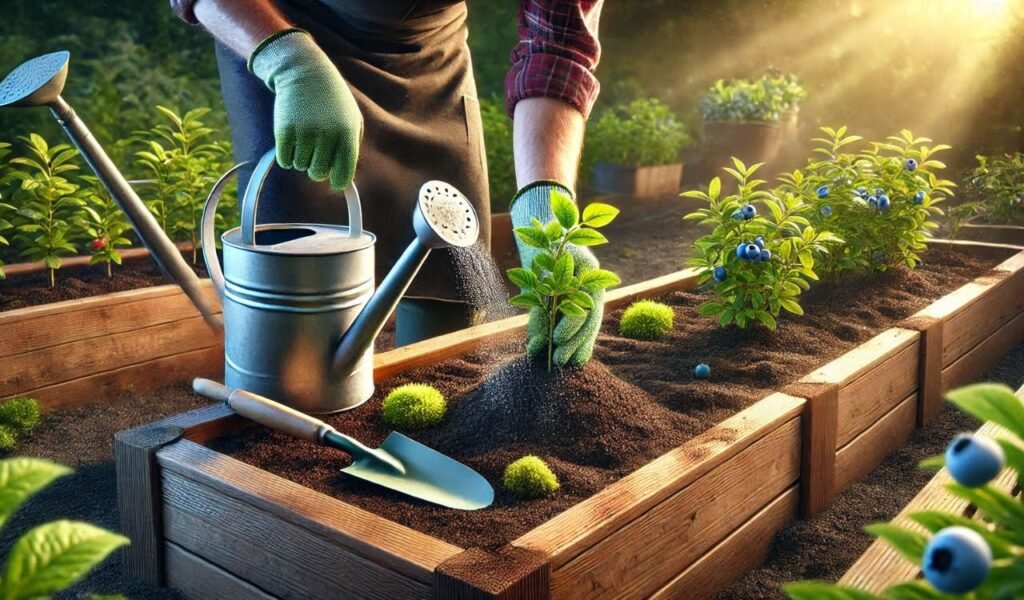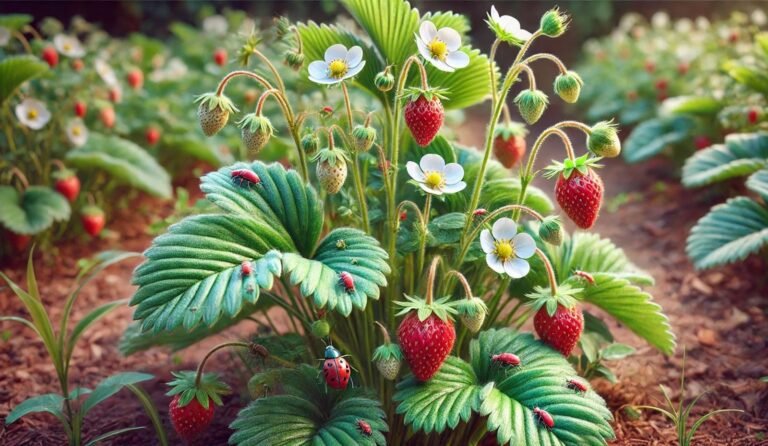Blueberry Plant Without Proper Drainage: A Recipe for Disaster & How to Fix It
A blueberry plant without proper drainage is basically a ticking time bomb. Too much water? Say hello to root rot, stunted growth, and zero berries. These plants hate soggy feet and will struggle if their roots stay wet for too long. But don’t worry—you don’t have to watch your blueberry dreams drown. With the right soil, setup, and a few simple tweaks, you can fix drainage issues fast. Ready to save your blueberry plant? Let’s dive in!
Why Proper Drainage Matters for Blueberry Plants
Blueberry plant without proper drainage– when it comes to growing blueberries, drainage is everything. Unlike some hardy plants that can survive in soggy conditions, blueberries are particularly sensitive to excess moisture. They require well-draining soil to ensure their roots receive oxygen while preventing rot and fungal infections. Drainage plays a crucial role in how water moves through the soil.
If water cannot escape properly, it creates a stagnant environment where the roots become suffocated. Blueberry roots are relatively shallow and fine, making them more vulnerable to poor drainage than other plants with deep or fibrous root systems. Additionally, blueberries thrive in acidic soil with a pH range between 4.5 and 5.5.
If the soil is poorly drained, it can become compacted, disrupting the delicate balance of nutrients needed for proper growth. Without proper drainage, even if you provide the best fertilizers and sunlight, your plant may never reach its full potential.
Signs That Your Blueberry Plant Lacks Proper Drainage
If you’re unsure whether your blueberry plant is suffering due to poor drainage, look for these telltale signs:
- Yellowing or Wilting Leaves: When roots sit in waterlogged soil, they struggle to absorb oxygen. This leads to nutrient deficiencies, causing leaves to turn yellow, wilt, or drop prematurely.
- Stunted Growth: Blueberries need a strong root system to grow vigorously. If the roots are constantly wet, they become weak and fail to support proper shoot and leaf development. Your plant may remain small and fail to produce healthy flowers or fruit.
- Water Pooling Around the Base: After watering your plant, does water sit on the surface for an extended period instead of draining quickly? If so, your soil likely has poor drainage.
- Mushy, Dark, or Foul-Smelling Roots: Healthy roots should be firm and light in color. If you dig into the soil and find dark, mushy, or foul-smelling roots, your plant is likely suffering from root rot, a serious issue caused by excessive moisture.
- Mold or Fungal Growth on Soil Surface: Standing water encourages fungal growth, which can be harmful to the plant. If you notice mold, mildew, or a white crust on the soil, this is a strong sign of poor drainage.
- Reduced Fruit Production: If your blueberry plant is not producing as much fruit as expected, poor drainage might be the culprit. A stressed plant diverts its energy to survival rather than fruiting.
The Consequences of Poor Drainage on Blueberry Plants

Many people don’t realize just how detrimental poor drainage can be for blueberry plants until it’s too late. Here’s what happens when excess water lingers in the soil:
Root Rot and Plant Death
One of the most severe consequences of poor drainage is root rot. This fungal disease attacks the roots, making them incapable of absorbing water and nutrients. Eventually, the entire plant wilts and dies, even though the soil appears moist.
Increased Susceptibility to Pests and Diseases
A weakened plant is an easy target for pests and diseases. Waterlogged conditions create an ideal breeding ground for harmful fungi and bacteria, leading to problems such as leaf spot, powdery mildew, and fungal infections.
Soil Compaction and Nutrient Deficiencies
When soil stays wet for too long, it becomes compacted, reducing air pockets essential for root respiration. Compacted soil also interferes with nutrient absorption, making it difficult for plants to take in vital minerals like nitrogen, phosphorus, and potassium.
Weakened Root System and Lack of Stability
Blueberries rely on their roots to anchor them in place. When the roots are weak due to prolonged exposure to excessive moisture, they fail to support the plant, making it more susceptible to falling over or struggling against strong winds.
How to Fix Drainage Issues for Blueberry Plants

Now that we understand the dangers of poor drainage, let’s dive into effective solutions.
1. Choosing the Right Soil for Blueberries
Blueberries require well-draining, acidic soil to thrive. Heavy clay or compacted soil retains too much moisture and should be avoided. Instead, use a mix of the following:
Peat Moss: Helps retain moisture while improving drainage.
Pine Bark Fines: Enhance aeration and acidity.
Sand or Perlite: Prevents soil compaction and increases drainage capacity.
If your natural garden soil doesn’t drain well, consider creating a custom mix with these ingredients to provide an ideal growing environment.
2. Planting in Raised Beds or Containers
For gardeners dealing with poor native soil, raised beds or containers are a game-changer. Raised beds allow excess water to drain more easily than flat ground planting. When using containers, always ensure they have sufficient drainage holes at the bottom.
3. Improving Drainage in an Existing Garden Bed
If your blueberries are already planted in an area with poor drainage, you can take steps to improve their conditions:
Amend the Soil: Mix organic matter like compost or peat moss into the existing soil to loosen it and improve water flow.
Use a French Drain: Dig a trench filled with gravel or perforated pipes to help excess water drain away from the roots.
Slope the Planting Area: Ensure that the planting site has a slight slope to prevent water from pooling around the roots.
4. Adjusting Your Watering Routine
One of the simplest ways to prevent waterlogged soil is to adjust your watering habits. Blueberries prefer consistently moist but not soggy soil. Water deeply but less frequently, allowing the soil to dry out slightly between watering sessions. Check soil moisture by sticking your finger about two inches deep—if it feels wet, hold off on watering.
5. Mulching for Moisture Control
Applying a layer of mulch around your blueberry plants can help regulate moisture levels. Organic mulch like pine needles, wood chips, or straw prevents excessive evaporation while allowing water to drain efficiently. It also keeps weeds at bay and helps maintain the soil’s acidity.
Preventative Measures to Avoid Future Drainage Issues
Ensuring your blueberry plants have proper drainage from the start can save you a lot of trouble down the line. Here are some preventative steps to take:
Test Your Soil Regularly: Use a soil pH tester to ensure your soil remains within the optimal acidic range for blueberries.
Check for Proper Drainage Before Planting: Conduct a drainage test by digging a hole and filling it with water. If it takes more than an hour to drain, amend the soil before planting.
Rotate Locations Every Few Years: If growing in-ground, consider rotating your blueberry plants to fresh soil every few years to prevent soil compaction.
FAQ
What happens to a blueberry plant without proper drainage?
It can develop root rot, stunted growth, yellow leaves, and reduced fruit production due to excess moisture suffocating the roots.
How can I tell if my blueberry plant has drainage issues?
Look for water pooling around the base, wilting or yellowing leaves, and mushy, dark roots—these are all signs of poor drainage.
What type of soil is best for drainage in blueberry plants?
Blueberries thrive in well-draining, acidic soil. A mix of peat moss, pine bark, and sand or perlite works best.
Can I grow a blueberry plant in a pot to improve drainage?
Yes! Choose a pot with drainage holes and use a light, well-aerated soil mix to prevent water from sitting at the roots.
How often should I water a blueberry plant to avoid overwatering?
Water deeply once or twice a week, allowing the topsoil to dry slightly between waterings. Adjust based on climate and rainfall.
Will adding mulch help with drainage for my blueberry plant?
Yes! Organic mulch like pine needles or wood chips helps regulate moisture, keeping the soil from becoming too wet or too dry.
Conclusion
A blueberry plant without proper drainage is a recipe for disaster. While blueberries are relatively easy to grow, they have specific needs when it comes to soil and water management. Poor drainage can lead to root rot, stunted growth, disease, and ultimately, plant death.
However, by choosing the right soil, planting in raised beds or containers, improving your watering habits, and using mulch, you can create the perfect environment for your blueberry bushes to flourish. If you’re experiencing drainage issues, don’t panic! Follow the tips in this guide, and soon, you’ll have a thriving blueberry plant that produces delicious, healthy berries year after year. Happy gardening!







